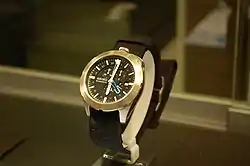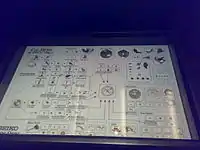Spring Drive
The Spring Drive is a watch movement conceived in 1977 by Yoshikazu Akahane (赤羽 好和) at Suwa Seikosha[1] (now a part of Seiko Epson after a 1985 merger).[2] Specified to one second accuracy per day,[3] the movement uses a conventional gear train as in traditional mechanical watches, but rather than an escapement and balance wheel, instead features Seiko's Tri-synchro Regulator system in which power delivery to the watch hands is regulated based on a reference quartz signal.[3]

Commercially released in 1999,[2] the movement is found in watches distributed by the Seiko Watch Corporation, including its Credor, Grand Seiko, and Prospex brands.
Mechanics
The Spring Drive uses a conventional mainspring[3] and barrel[4] along with automatic and/or stem winding to store energy, just as in a traditional mechanical watch.[3] However, the conventional escapement and balance wheel in traditional mechanical watches is replaced by Seiko's Tri-synchro Regulator system, a phase-locked loop wherein a rotor, which Seiko refers to as a "glide wheel", is powered by the mainspring barrel via a stator. The glide wheel in turn powers a reference quartz crystal and accompanying integrated circuit which controls an electromagnetic brake which then regulates the rotational speed of the glide wheel itself.[3]
The glide wheel is intended to rotate eight times per second; the rotational speed is sampled once every rotation and a variable braking force is continuously applied to maintain that target frequency. As the glide wheel directly powers the seconds hand of the watch, this results in a true continuously sweeping second hand - in contrast to the beats per time motion resulting from the back-and-forth movement of traditional mechanical watches or the tick of typical quartz watches.[3]
The movement is specified to ±15 seconds per month.[5]
History
The design was first conceived by Yoshikazu Akahane at Suwa Seikosha in 1977[1] and patents were applied for it in 1982;[5] in total, no fewer than 230 patents have been applied worldwide for this movement.[6] Initial development was hindered by the high energy consumption of the reference quartz crystal and integrated circuit[5] making a watch with a then-target 48-hour power reserve impossible;[7] another attempt in 1993 was also unsuccessful for the same reason.[5] It was not until a third attempt in 1997, using a quartz crystal and integrated circuit with energy consumption approximately one one-hundredth that used in the initial attempt in 1982[7] that a Spring Drive watch with sufficient power reserve was deemed feasible.[5] Over 600 prototypes were produced during development.[1][3][8]
The Spring Drive movement was announced publicly in 1997 and presented at the 1998 Basel Watch Fair.[1][8] In 1999, the first production models were made available in Japan as limited edition, manual-wind watches in both the Credor and Seiko brands.[2][5][8] The first non-limited model was released in Japan in 2002.[5]
The 1st spring drive automatic-wind movement of Grand Seiko was released in September, 2004, the reference number is SBGA001.
The first automatic-wind Spring Drive model was released in 2005[8] and coincided with the introduction of the Spring Drive movement to markets outside of Japan.[8]
Calibers

Early models, manual wind and 48h power reserve:
- 7R68 : 30 jewels, date.
- 7R78 : 30 jewels, date.
- 7R88 : 30 jewels, date.
- 7R99 : 32 jewels.
Current calibers with standard features. Time accuracy: monthly rate within ±15 sec (equivalent to a daily rate of ±1 sec) and power reserve (72h) indicator.
- 5R64 : 32 jewels, date, small seconds hand.
- 5R65 : 30 jewels, date.
- 5R66 : 30 jewels, date, GMT.
- 5R67 : 30 jewels, Moon Phase indicator.
- 5R77 : 30 jewels, Moon Phase indicator.
- 5R85 : 49 jewels, date, Chronograph, Izul.
- 5R86 : 50 jewels, date, GMT, Chronograph, Spacewalk.
- 7R06 : 88 jewels, manual winding, Sonnerie.
- 7R08 : 44 jewels, manual winding, Eichi I.
- 7R11 : 112 jewels, manual winding, Minute Repeater.
- 7R14 : 41 jewels, manual winding, Eichi II.
- 9R01 : 56 jewels, manual winding.
- 9R15 : 30 jewels, date.
- 9R65 : 30 jewels, date.
- 9R66 : 30 jewels, date, GMT.
- 9R84 : 41 jewels, date, Chronograph.
- 9R86 : 50 jewels, date, GMT, Chronograph.
- 9R96 : 50 jewels, date, GMT, Chronograph.
- 9RA5 : 38 jewels, date.
Notes and references
- "Time passes beautifully on elegant, high-quality watch". japantimes.co.jp. The Japan Times. 26 March 2018. Retrieved 11 April 2019.
- "Seiko/Credor Spring Drive", Milestone Products, Seiko Epson
- "spring drive movement about". grand-seiko.com. Grand Seiko. Retrieved 11 April 2019.
- "HISTORY - ABOUT - Grand Seiko". grand-seiko.com. Grand Seiko. Retrieved 20 October 2019.
- "Seiko/ Credor Spring Drive" (PDF). global.epson.com. Seiko Epson. December 1999. Retrieved 20 October 2019.
- "Seiko launches limited edition watches". India Today. 2 February 2012. Retrieved 20 October 2019.
- Bredan, David (5 February 2017). "The Amazing History & Functionality Of The Seiko Spring Drive Movement". Retrieved 20 October 2019.
- "Seiko Spring Drive The Quiet Revolution" (PDF). seikospringdrive.com. Seiko Watch Corporation. Retrieved 20 October 2019.